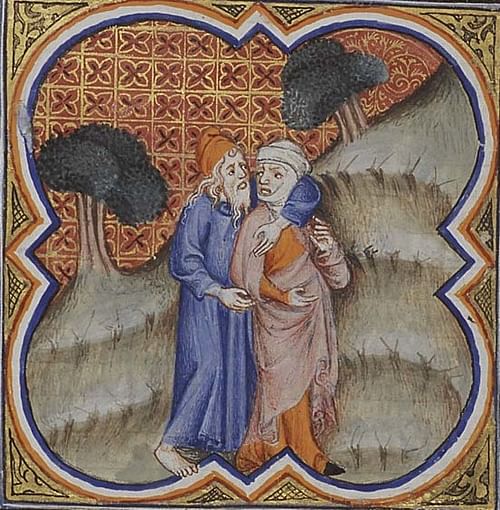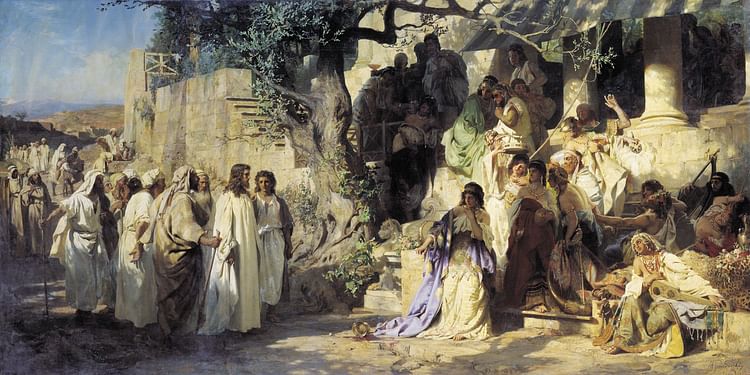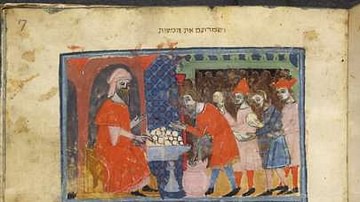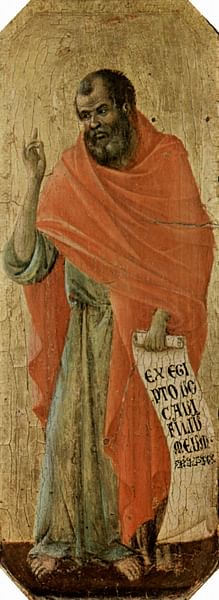
Hosea is listed as the first of the twelve minor prophets in the Hebrew Bible. He was active in the 8th century BCE and his ministry extended over 60 years, from King Jeroboam II (787-747 BCE) to King Hoseah (731-722 BCE). He was one of the first to write down his prophecies. Hosea ("salvation") may have derived from Joshua ("he saves").
Prophets
Prophets were the Jewish version of oracles in the ancient world. It was a term for a person as well as a place. Categorized as divination, this was the way humans communicated with their gods. The oracle was possessed by the deity and served as a vehicle for the words. Sometimes the deity appeared in a vision. At other times, the prophet could experience an out-of-body journey to heaven and receive information from God or his angels.
In 722 BCE, the Assyrian Empire conquered and destroyed the Northern Kingdom of Israel. This was when ten of the twelve tribes of Israel were lost to history. In 587 BCE, the Babylonian Empire conquered and destroyed the Southern Kingdom of Judah and Solomon's Temple in Jerusalem. The prophets of Israel explained both disasters by claiming that the sins of the Israelites (specifically their idolatry) led God to punish them. However, they also offered a message of hope: sometime in the future, God would intervene once more in the final days (eschaton in Greek). At that time, he would restore Israel to its former glory and rectify all injustice. With no specific details in the Book of Hosea, it is nevertheless the consensus that his activity focused on the Northern Kingdom of Israel.
The Sexual Immorality of Idolatry
A dominant theme in the construction of ancient religious views was the necessity of fertility; fertility of people, crops, and herds. Thus, gods were always depicted as accompanied by goddesses (consorts), and human procreation became essential for survival. The prophets of Israel utilized allegory and metaphors of sexual intercourse, adultery, marriage, and divorce to critique these concepts where they claimed that the sin of idolatry led to sexual immorality. In the Jewish texts, the term meant illicit sexual unions, and most often referred to incest laws, the degree of kinship permitted in marriage (Leviticus 18).
In Greek, the term for illicit sexual unions was pornea. It was later translated into the Latin forne (arches), which alluded to the way prostitutes practiced their trade under the arches, and so our modern terms pornography and fornication became the standard translations in English Bibles. Sexual immorality came to be applied to all forms of human sexuality not condoned by a group. The Book of Hosea was one of the first to apply allegory and metaphors of human sexuality to denounce the sins of the Israelites.
Hosea charged the Northern Kingdom with theft, perjury, and idolatry that led to their sexual immorality. The sexual nuance is derived from the Canaanite Baals, and their consorts, Asherahs. Baal was sometimes depicted as a pillar on a mountaintop (symbolizing a potent phallus), but more commonly he was a bull because bulls were an ancient symbol of fertility and potency. When the Northern Kingdom separated from the South Kingdom of Judah, a temple was built at Bethel with a Baal in the image of a bull. Asherah was often depicted with exaggerated breasts as a symbol of potential nurturing.
Adultery & a Message of Hope in Hosea
When the Lord began to speak through Hosea, the Lord said to him, "Go, marry a promiscuous woman and have children with her, for like an adulterous wife this land is guilty of unfaithfulness to the Lord." So he married Gomer daughter of Diblaim, and she conceived and bore him a son. Then the Lord said to Hosea, "Call him Jezreel, because I will soon punish the house of Jehu for the massacre at Jezreel, and I will put an end to the kingdom of Israel. ... Gomer conceived again and gave birth to a daughter. Then the Lord said to Hosea, "Call her Lo-Ruhamah (which means "not loved"), for I will no longer show love to Israel, ..." After she had weaned Lo-Ruhamah, Gomer had another son. Then the Lord said, "Call him Lo-Ammi (which means "not my people"), for you are not my people, and I am not your God." (Hosea 1:2-9)
In the ancient world, women were considered the property of men. Marriage contracts served as a means of detailing property laws. Technically, adultery was the violation of another man's property. In ancient Judaism (at least in the Laws of Moses), the punishment for adultery was death by stoning for both the man and the woman. The punishment was severe because a clear conviction that the fetus was fathered by the legal husband was dominant in the tracing of bloodlines from generation to generation. There were no paternity or DNA tests.
Hosea construed Israel's unfaithfulness as committing adultery against God's relationship with Israel; God was the bridegroom and Israel the bride. Gomer ran away and slept with another man (or men). The marriage symbolized the breakdown between God and his people because his people turned to other gods. All the children's names are symbolic of this estrangement from God. Almost all of Chapter 2 is a tirade against unfaithfulness:
Rebuke your mother, rebuke her, for she is not my wife, and I am not her husband. Let her remove the adulterous look from her face and the unfaithfulness from between her breasts. Otherwise I will strip her naked and make her as bare as on the day she was born; I will make her like a desert, turn her into a parched land, and slay her with thirst. I will not show my love to her children, because they are the children of adultery. Their mother has been unfaithful and has conceived them in disgrace. (Hosea 2:2-5)
But the passage ends with "I will betroth you to me forever; I will betroth you in d righteousness and justice, in love and compassion. I will betroth you in faithfulness, and you will acknowledge the Lord" (Hosea 2:19-20). A betrothal was another legal contract. Some scholars have described Hosea as utilizing a concept known as an ancient covenant lawsuit. Covenants were contracts between a god and his/her community. A breach by either side of a contract could result in a lawsuit. Hosea's language reflects such a charge by God, that the terms of his contract with Israel had been broken.
Even though Gomer committed adultery, when Hosea found that she had been sold into slavery to another man, he bought her back and took her in because he loved her. This reflects the other side of his message, that God's love for Israel will ultimately forgive and restore the nation. This section became a popular tradition in Second Temple Judaism, demonstrating God's mercy and willingness to forgive all those who repented and turned (back) to God.
Sometimes compared to the prophecies of Amos, Hosea became honored as one of the first to highlight what became known as ethical monotheism in Judaism. This was understanding that God was moral by nature. In other words, God did not arbitrarily punish, but only when he had reasons to do so; he had to punish because of his innate holiness.
Historicity
The scholarly consensus places the Book of Hosea within the parameters of events in the 8th century BCE, and the fall of the Northern Kingdom, but debates center on the literal acceptance of Hosea's polemic and metaphors. Did the ancient Israelites commit idolatry, or should Hosea only be understood as metaphors? Hosea referred to statuettes and cult objects, and these items have been uncovered in archaeological excavations of the Israelite period in Israel.
It should be noted that if, in fact, the Israelites included these objects in their prayers, this would not necessarily violate the ancient command to worship only the God of Israel. Our modern concept of monotheism defines this as belief in one God, but the ancients did not articulate such an idea in the same manner; the Jewish heaven was just as crowded with levels of divinity as their neighbors. Throughout the Jewish Scriptures, it is claimed that the God of Israel created all the other gods. What distinguished Jews from everyone else was the command that they could only worship the God of Israel. However, worship in the ancient world specifically meant sacrifices, not belief the way we understand it.
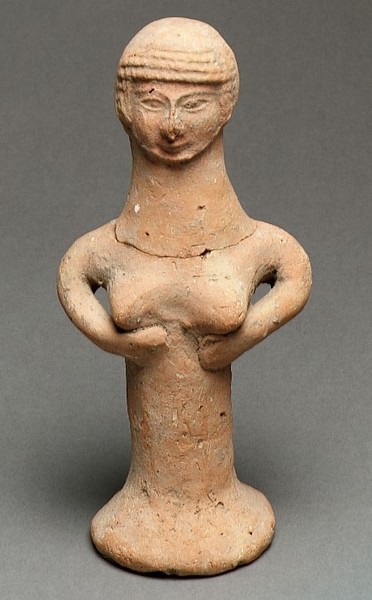
For example, one could pray to or petition an angel, but only God could receive offerings. Jews were also commanded to respect all the other gods. Ancient Jews could have participated in various degrees of Baal worship, as an extra plea, without thinking that it violated the first and second of the ten commandments: "You shall have no other gods before me" and "You shall not make for yourself an image in the form of anything" (Exodus 20:3-4)
Through interpretation, the "no other gods before me" could be understood as "no other gods above or beside me" in relation to worship (sacrifices). The "image in the form of anything," or "graven image" as it is translated in the King James Bible, is more problematic. Does it forbid a graven image in the likeness of the God of Israel or all gods? Some scholars are convinced of the Israelites' idolatry because Hosea said that they made offerings to the Baals and carved images of them. On the other hand, the polemic against idolatry is also an after-the-fact rationalization to explain God permitting the destruction of the Northern Kingdom. Polemic is not historical evidence.
We read the texts through the eyes of the modern understanding of monotheism (belief in one god), but there was no such concept as Judaism as a systematic belief system until centuries later. It is better to think of Judaisms; various communities of Jews shared the Law of Moses but interpreted and worked it out in their daily lives throughout the region.
Sacred Prostitution
When the early archaeologists of the Victorian Era began excavating throughout the Middle East, they uncovered cuneiform texts that revealed much about ancient religious cults. Ancient Sumer had a yearly ritual, hieros gamos (sacred marriage) where the king 'coupled' with the goddess Inanna who was the goddess of sexual love, fertility, and warfare. The symbolic purpose was to revitalize the potency and virility of the king, who was also responsible for rain, the fertility of crops and herds, and war.
The Jewish Scriptures have two different words, zonah and kedeshah for prostitution in the ancient Mediterranean. Zonah referred to a common street prostitute (the promiscuous or loose woman such as Gomer). Kedeshah (a woman set apart as consecrated or holy) may refer to a woman who acted as a servant in fertility temples. There were also male equivalents who acted as such servants.
Scholars who focus on rituals as acts claim that ritual sexual intercourse could have been an 'acting out' of the purpose of a religious petition, resulting in fertility. Through the writings of Pindar, Herodotus, Xenophon, Strabo, and many others, these activities were highlighted especially in the many temples to Aphrodite (and her namesakes) throughout the Mediterranean. Unfortunately, the concept acquired a negative connotation known as Temple prostitution, or sacred prostitution, in the Western tradition.
Scholars continue to debate the reality of these practices. The sheer abundance of these rituals in ancient literature leads many to be convinced. In relation to the archaeological record, however, the evidence is slight; many ancient temples had side-rooms or cells, where such activity could occur. Then as now, polemical accusations against others who practiced secret rites, such as the Mysteries, consistently assumed deviant sexual practices of the initiates. Whether historical or not, all of this combined with Hosea's metaphors resulted in the Western tradition that idolatry always led to sexual immorality which led to disaster and destruction. According to the prophets, the national disasters of Israel occurred because they 'whored after' the idols.
Hosea in Christianity
Christians consistently turned the Books of the Prophets to validate their claim that Jesus of Nazareth was the messiah ("anointed one") who would lead the Israelites to their promised restoration. When Matthew opened his gospel with descriptions of Jesus as the new Moses, he included many allusions to the stories of Egypt in Exodus. The story of the family's flight into Egypt and their subsequent return were validated upon Hosea 11:1: "When Israel was a child, I loved him, and out of Egypt I called my son."
Another quote was applied when Matthew's Jesus was asked by the Pharisees, "Why does your teacher eat with tax collectors and sinners?" (Matthew 9:11). Jesus said, "It is not the healthy who need a doctor, but the sick. But go and learn what this means: 'I desire mercy, not sacrifice.' For I have not come to call the righteous, but sinners" (Matthew 9:12-13) In the Gospel of Matthew, Jesus is quoting Hosea 6:6: "For I desire mercy, not sacrifice, and acknowledgment of God rather than burnt offerings."
Matthew also included Hosea's marriage analogies in his kingdom parables:
Then John's disciples came and asked him, "How is it that we and the Pharisees fast often, but your disciples do not fast?" Jesus answered, "How can the guests of the bridegroom mourn while he is with them? The time will come when the bridegroom will be taken from them; then they will fast." (Matthew 9:14-15)
Later Christian writers extended the analogy to the Church: Christ is the husband, and the Church is his bride. The buying back of Gomer (as a repentant sinner) was utilized to explain the redemptive power of Jesus Christ's sacrifice on the cross. The Christian historian Eusebius claimed that Roman emperor Constantine I (306-337 CE) closed many temples to Venus in the 4th century, although they continued in Phoenicia and Baalbek. Although 800 years separated Christians from the time of Hosea, nevertheless, his metaphors of sex and idolatry were now transferred to denounce the lifestyles and behavior in the charge of sexual immorality found in pagan (non-Christian) culture.
Hosea is commemorated by Jews on Tisha B'av (the day of the destruction of both Temples) and in the Eastern Orthodox calendar on October 17. A medieval Jewish tradition claims that the tomb of Hosea is located in the city of Safed in Israel, although there is an absence of evidence for this claim.
A line from Hosea was quoted by Sir Winston Churchill when he encouraged the Christian nation of England to have hope during WWI: "They sow the wind and reap the whirlwind. The stalk has no head; it will produce no flour. Were it to yield grain, foreigners would swallow it up" (Hosea 8:7).

